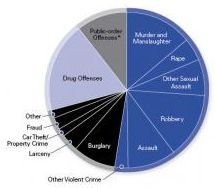“The U.S. Bureau of Justice Statistics reports that two-thirds of released prisoners are rearrested for at least one serious new crime, and more than half are re-incarcerated within three years of release.”
The announcement last summer that the number of Americans behind bars had increased for the 37th consecutive year in 2009 provoked a fresh round of grim editorializing and national soul-searching. With its prisons and jails now holding more than 2.4 million inmates — roughly one in every 100 adults — the United States has the highest incarceration rate of any free nation. As a proportion of its population, the United States incarcerates five times more people than Britain, nine times more than Germany, and 12 times more than Japan. “No other rich country is nearly as punitive as the Land of the Free,” The Economist has declared.
But a highly significant fact went largely unremarked amid the hubbub: The population of the nation’s state prisons, which house all but a relative handful of convicted felons, decreased by nearly 3,000. Although the drop was slight in percentage terms, it was the first since 1972. (State prisons held 1.4 million inmates at the end of 2009 and federal prisons more than 200,000, while the number held in local jails, mostly for minor crimes, averaged about 770,000 over the course of the year, and the majority had yet to face trial.) In California, which has the nation’s largest state prison system, with nearly 170,000 men and women behind bars, the prison population fell for the first time in 38 years. The national prison population — including those held in federal facilities — grew by less than one percent, the slowest rate in the last decade.
